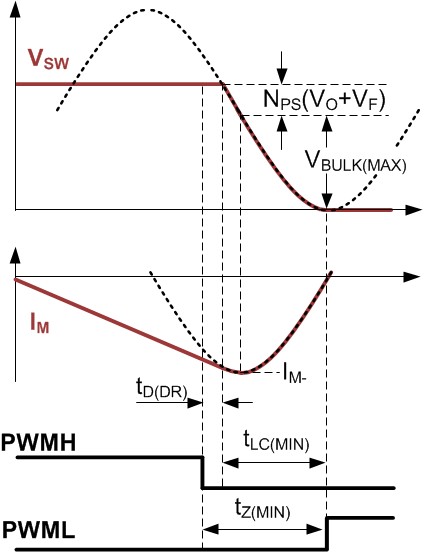JAJSE40A October 2017 – February 2018 UCC28780
PRODUCTION DATA.
- 1 特長
- 2 アプリケーション
- 3 概要
- 4 改訂履歴
- 5 Pin Configuration and Functions
- 6 Specifications
-
7 Detailed Description
- 7.1 Overview
- 7.2 Functional Block Diagram
- 7.3
Detailed Pin Description
- 7.3.1 BUR Pin (Programmable Burst Mode)
- 7.3.2 FB Pin (Feedback Pin)
- 7.3.3 VDD Pin (Device Bias Supply)
- 7.3.4 REF Pin (Internal 5-V Bias)
- 7.3.5 HVG and SWS Pins
- 7.3.6 RTZ Pin (Sets Delay for Transition Time to Zero)
- 7.3.7 RDM Pin (Sets Synthesized Demagnetization Time for ZVS Tuning)
- 7.3.8 RUN Pin (Driver Enable Pin)
- 7.3.9 SET Pin
- 7.4
Device Functional Modes
- 7.4.1 Adaptive ZVS Control with Auto-Tuning
- 7.4.2 Dead-Time Optimization
- 7.4.3 Control Law across Entire Load Range
- 7.4.4 Adaptive Amplitude Modulation (AAM)
- 7.4.5 Adaptive Burst Mode (ABM)
- 7.4.6 Low Power Mode (LPM)
- 7.4.7 Standby Power Mode (SBP)
- 7.4.8 Startup Sequence
- 7.4.9 Survival Mode of VDD
- 7.4.10 System Fault Protections
- 7.4.11 Pin Open/Short Protections
-
8 Application and Implementation
- 8.1 Application Information
- 8.2
Typical Application Circuit
- 8.2.1 Design Requirements
- 8.2.2 Detailed Design Procedure
- 8.2.3 Application Curves
- 9 Power Supply Recommendations
- 10Layout
- 11デバイスおよびドキュメントのサポート
- 12メカニカル、パッケージ、および注文情報
パッケージ・オプション
デバイスごとのパッケージ図は、PDF版データシートをご参照ください。
メカニカル・データ(パッケージ|ピン)
- D|16
- RTE|16
サーマルパッド・メカニカル・データ
- RTE|16
発注情報
7.3.6 RTZ Pin (Sets Delay for Transition Time to Zero)
The dead-time between PWMH falling edge and PWML rising edge (tZ) serves as the wait time for VSW transition from its high level down to the target ZVS point. Since the optimal tZ varies with VBULK, the internal dead-time optimizer automatically extends tZ as VBULK is less than the highest voltage of the input bulk capacitor (VBULK(MAX)). The circulating energy for ZVS can be further reduced, obtaining higher efficiency at low line versus a fixed dead-time over a wide line voltage range. A resistor on RTZ pin (RRTZ) programs the minimum tZ (tZ(MIN)) at VBULK(MAX), which is the sum of the propagation delay of the high-side driver (tD(DR)) and the minimum resonant transition time of VSW falling edge (tLC(MIN)).

where KTZ is equal to 11.2×1011 (unit: F-1) for VSET = 0 V, and 5.6×1011(unit: F-1) for VSET = 5 V. As illustrated in Figure 18, after PWMH turns off QH after tD(DR) delay, the negative magnetizing current (iM-) becomes an initial condition of the resonant tank formed by magnetizing inductance (LM) and the switch-node capacitance (CSW). CSW is the total capacitive loading on the switch-node, including all junction capacitance (COSS) of switching devices, stray capacitance of the boot-strap diode, intra-winding capacitance of the transformer, the snubber capacitor, and parasitic capacitance of the PCB traces between switch-node and ground. Unlike a conventional valley-switching flyback converter, the resonance of an active clamp flyback converter at high line does not begin at the peak of the sinusoidal trajectory. The transition time of VSW takes less than half of the resonance period. The following tLC(MIN) expression quantifies the transition time for RRTZ calculation, where an arccosine term represents the initial angle at the resonance beginning. The value of π minus the arccosine term at VBULK(MAX) of 375 V, VO of 20 V, and NPS of 5 is around 0.585π, which is close to one quarter of the resonance period.

 Figure 18. RTZ Setting for the Falling-edge Transition of VSW
Figure 18. RTZ Setting for the Falling-edge Transition of VSW